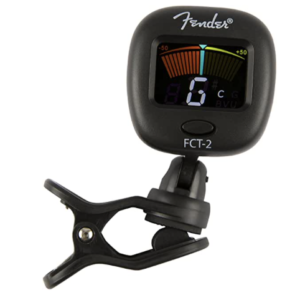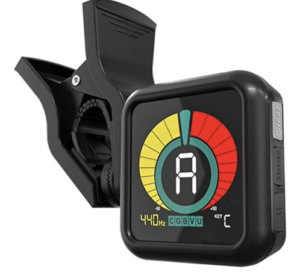In this article you’ll learn how to tune a guitar with a tuner. For this you need to follow a simple, step by step process.
Step 1: Get a Digital Guitar Tuner
To tune a guitar, the easiest way nowadays is to use a digital tuner.
They come in several shapes and form. Here is a list of the most popular digital guitar tuners:
This tuner is produced by Fender, the number one brand in electrical guitar and accessories.
It is easy to use.
Also, it is small and compact.
It is very precise.
KLIQ UberTuner – Professional Clip-On Tuner
KLIQ tuner is a very precise and professional tuner.
Has a color coded display that is easy to use.
Can be used with a clip on the guitar.
Excellent price.
Snark SN5X Clip-On Tuner for Guitar
 The Snark SN5X is a very advanced tuner, which I use frequently.
The Snark SN5X is a very advanced tuner, which I use frequently.
It is also one of the lest expensive ones.
Very easy to read at night.
The clip on snatches easily to the guitar neck.
I have used each of these tuners and they do a great job.
Step 2: Prepare the Digital Tuner
Most digital tuners have an easy to adjust digital screen that will show you the notes. However, you need to make sure that they are in the right tuning mode.
Some tuners are able to tune not only the guitar, but other instruments such as a bass or violin.
Make sure that you tuner is set for the guitar. In most models, they will show a letter G on the corner, meaning that the tuner is set for the guitar.
Step 3: Tune Each Guitar String
The next step is to play each guitar string and observe what is displayed in the tuner.
First, you need to remember the note for each string. From top to bottom, the guitar strings have notes E, A, D, G, B, and E.
When playing each string, your goal is to make sure that the note corresponding to that string shows up in the tuner. However, this will not happen initially when the strings are untuned.
So, your goal is to move the string until it gets to the desired node.
For example, let’s tune the bottom string E. If the tuner shows a lower note like C, D, or D#, you need to move the tuning knob counter clockwise, so that the pitch of the string will increase, until it gets to E.
On the other hand, if the tuner is showing a higher pitch, like F, F#, or G, you need to move the tuning knob clockwise, so the pitch will go down to E.
The same process needs to be repeated on each string, until they get to their correct pitch. This will result in the sequence of notes E, A, D, G, B, and E.
Step 4: Make Adjustments
Once you get the strings to the right pitch, it is time to go back and make little adjustments.
Sometimes it is necessary to make these adjustments, because strings have a tendency to slip back a little, until they settle to their new position.
Make sure that the tuning indicator for each string is right in the middle: it shouldn’t be flat or higher than the standard pitch.
Once you check the correct pitch again for each string, then you should be good. Play a few chord and see if they sound ok. If this check doesn’t sound good, you probably missed one of the strings.
To learn some chords that sound great on a guitar, check here.
Get A Free Guide
I have created a free PDF course (60 pages) covering basic guitar information like this. The course if free and sent by email once you request it here. Just click here to get your free PDF guitar course.


